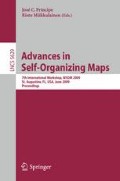Abstract
We introduce the Exploration Machine (Exploratory Observation Machine, XOM) as a novel versatile instrument for scientific data analysis and knowledge discovery. XOM systematically inverts structural and functional components of topology-preserving mappings. In contrast to conventional approaches known from the literature, this novel computational framework for self-organization does not require to incorporate additional graphical display or coloring techniques, or to modify topology-preserving mapping algorithms by additional regularization in order to recover the underlying cluster structure of inhomogeneously distributed input data. Thus, XOM can be seen as an approach to bridge the gap between nonlinear embedding and classical topology-preserving feature mapping. At the same time, XOM results in tremendous computational savings when compared to conventional topology-preserving mapping, thus allowing for direct structure-preserving visualization of large data collections without prior data reduction.
Access this chapter
Tax calculation will be finalised at checkout
Purchases are for personal use only
Preview
Unable to display preview. Download preview PDF.
References
Angeniol, B., De La Croix Vaubois, G., Le Texier, J.Y.: Self-organizing feature maps and the travelling salesman problem. Neural Networks 1, 269–293 (1988)
Cherry, J.M., Ball, C., Weng, S., Juvik, G., Schmidt, R., Adler, C., Dunn, B., Dwight, S., Riles, L., Mortimer, R.K.: Nature 387, 67–73 (1997)
Durbin, R., Willshaw, D.: An analogue approach to the travelling salesman problem using an elastic net method. Nature 326, 689–691 (1987)
Eisen, M.B., Spellman, P.T., Brown, P.O., Botstein, D.: Cluster analysis and display of genome-wide expression patterns. Proc. Natl. Acad. Sci. USA 95, 14863–14868 (1998)
Flexer, A.: On the use of self-organizing maps for clustering and visualization. In: Żytkow, J.M., Rauch, J. (eds.) PKDD 1999. LNCS, vol. 1704, pp. 80–88. Springer, Heidelberg (1999)
Goodhill, G.J., Sejnowski, T.: A unifying objective function for topographic mappings. Neural Comp. 9, 1291–1303 (1997)
Graepel, T., Burger, M., Obermayer, K.: Phase transitions in stochastic self-organizing maps. Physical Review E 56(4), 3876–3890 (1997)
Kaski, S.: Data exploration using self-organizing maps. Act Polytech Scand, Mathematics, Computing and Management in Engineering Series No. 82 (1997)
Kohonen, T.: Self-Organizing Maps, 3rd edn. Springer, Heidelberg (2001)
Milligan, G.W., Cooper, M.C.: An examination of procedures for determining the number of clusters in a data set. Psychometrika 50, 159–179 (1985)
Ritter, H., Martinetz, T., Schulten, K.: Neural Networks and Self-Organizing Maps. Addison-Wesley, New York (1992)
Vesanto, J.: SOM-based data visualization methods. Intelligent Data Analysis 3, 111–126 (1999)
Wiskott, L., Sejnowski, T.: Constrained optimization for neural map formation: a unifying framework for weight growth and normalization. Neural Comp. 10, 671–716 (1998)
Wismüller, A.: Exploratory Morphogenesis (XOM): A Novel Computational Framework for Self-Organization. Ph.D. thesis, Technical University of Munich, Department of Electrical and Computer Engineering (2006)
Author information
Authors and Affiliations
Editor information
Editors and Affiliations
Rights and permissions
Copyright information
© 2009 Springer-Verlag Berlin Heidelberg
About this paper
Cite this paper
Wismüller, A. (2009). A Computational Framework for Nonlinear Dimensionality Reduction and Clustering. In: Príncipe, J.C., Miikkulainen, R. (eds) Advances in Self-Organizing Maps. WSOM 2009. Lecture Notes in Computer Science, vol 5629. Springer, Berlin, Heidelberg. https://doi.org/10.1007/978-3-642-02397-2_38
Download citation
DOI: https://doi.org/10.1007/978-3-642-02397-2_38
Publisher Name: Springer, Berlin, Heidelberg
Print ISBN: 978-3-642-02396-5
Online ISBN: 978-3-642-02397-2
eBook Packages: Computer ScienceComputer Science (R0)

